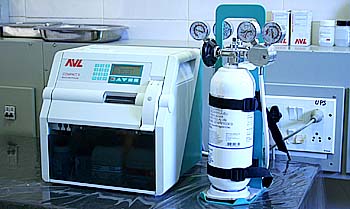arterial blood gas analysis

Arterial blood gas analyzer.
Arterial blood gas analysis, also called simply "blood gases," is a test done to measure how much oxygen, carbon dioxide, and bicarbonate is in the blood. It also looks at the acidity-alkalinity (pH) of the blood. Blood gas analysis is usually performed on blood from artery, although in rare cases blood from a vein may be used. The main purpose of the test is to evaluate respiratory diseases and conditions that affect the lungs, including emphysema, severe asthma, and chronic bronchitis. It helps determine the effectiveness of oxygen therapy. The acid-base component of the test also gives information about kidney function.
What the test involves
The test is performed using a small needle to collect a sample of blood from an artery. The sample may be collected from the radial artery in the wrist, the femoral artery in the groin, or the brachial artery in the arm. Before blood is drawn, the health care provider may test circulation to the hand (if the wrist is the site). After the blood is drawn, pressure applied to the puncture site for a few minutes stops the bleeding.
The test must be sent to the laboratory for analysis quickly to ensure accurate results.
Results
Normal blood test results at sea level are indicated in the table below.
| Normal results | |
|---|---|
| partial pressure of oxygen (PaO2) | 75–100 mm Hg |
| partial pressure of carbon dioxide (PaCO2) | 35–45 mm Hg |
| pH | 7.35–7.45 |
| oxygen saturation (SaO2) | 94–100% |
| bicarbonate (HCO3) | 22–26 mEq/liter |
At altitudes of 3,000 feet and above, the oxygen values are lower than at sea level.
Abnormal results may indicate respiratory, metabolic, or renal diseases. The results may also be abnormal with head or neck injuries, or other traumas that affect breathing.


